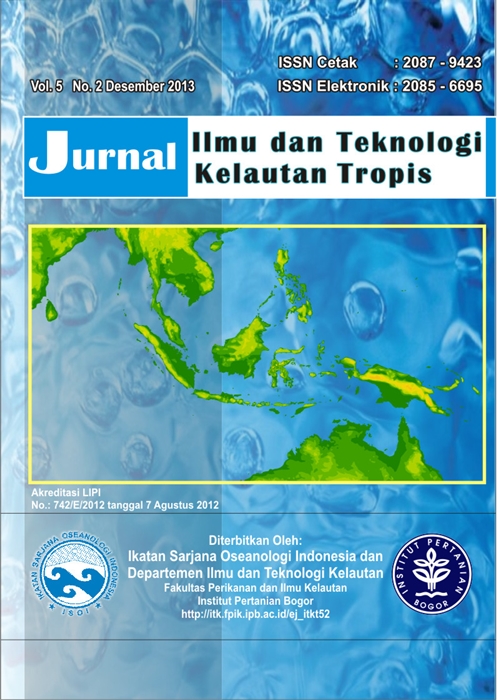SHALLOW WATER HABITAT MAPPING AND REEF FISH STOCK ESTIMATION USING HIGH RESOLUTION SATELLITE DATA
Abstract
Shallow marine waters comprise diverse benthic types forming habitats for reef fish community, which important for the livelihood of coastal and small island inhabitants. Satellite imagery provide synoptic map of benthic habitat and further utilized to estimate reef fish stock. The objective of this research was to estimate reef fish stock in complex coral reef of Pulau Pari, by utilizing high resolution satellite imagery of the WorldView-2 in combination with field data such as visual census of reef fish. Field survey was conducted between May-August 2013 with 160 sampling points representing four sites (north, south, west, and east). The image was analy-zed and grouped into five classes of benthic habitats i.e., live coral (LC), dead coral (DC), sand (Sa), seagrass (Sg), and mix (Mx) (combination seagrass+coral and seagrass+sand). The overall accuracy of benthic habitat map was 78%. Field survey revealed that the highest live coral cover (58%) was found at the north site with fish density 3.69 and 1.50 ind/m2at 3 and 10 m depth, respectively. Meanwhile, the lowest live coral cover (18%) was found at the south site with fish density 2.79 and 2.18 ind/m2 at 3 and 10 m depth, respectively. Interpolation on fish density data in each habitat class resulted in standing stock reef fish estimation: LC (5,340,698 ind), DC (56,254,356 ind), Sa (13,370,154 ind), Sg (1,776,195 ind) and Mx (14,557,680 ind).
Keywords: mapping, satellite imagery, benthic habitat, reef fish, stock estimation
Authors
This work is licensed under a Creative Commons Attribution 4.0 International License.
Jurnal Ilmu dan Teknologi Kelautan Tropis i is an open-access journal, meaning that all content is freely available without charge to the user or their institution. Users are allowed to read, download, copy, distribute, print, search, or link to the full texts of the articles in this journal without needing to request prior permission from the publisher or the author.
All articles published by Jurnal Ilmu dan Teknologi Kelautan Tropis are licensed under the Creative Commons Attribution 4.0 International License. This allows for unrestricted use, distribution, and reproduction in any medium, provided proper credit is given to the original authors.
Authors submitting manuscripts should understand and agree that the copyright of published manuscripts is retained by the authors. Copyright encompasses the exclusive rights of authors to reproduce, distribute, and sell any part of the journal articles in all forms and media. Reproduction of any part of this journal, its storage in databases, and its transmission by any form or media is allowed without written permission from Jurnal Ilmu dan Teknologi Kelautan Tropis.


